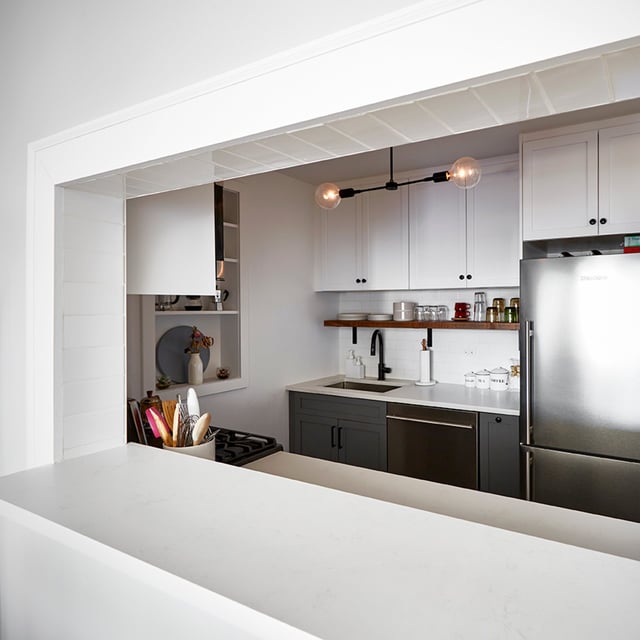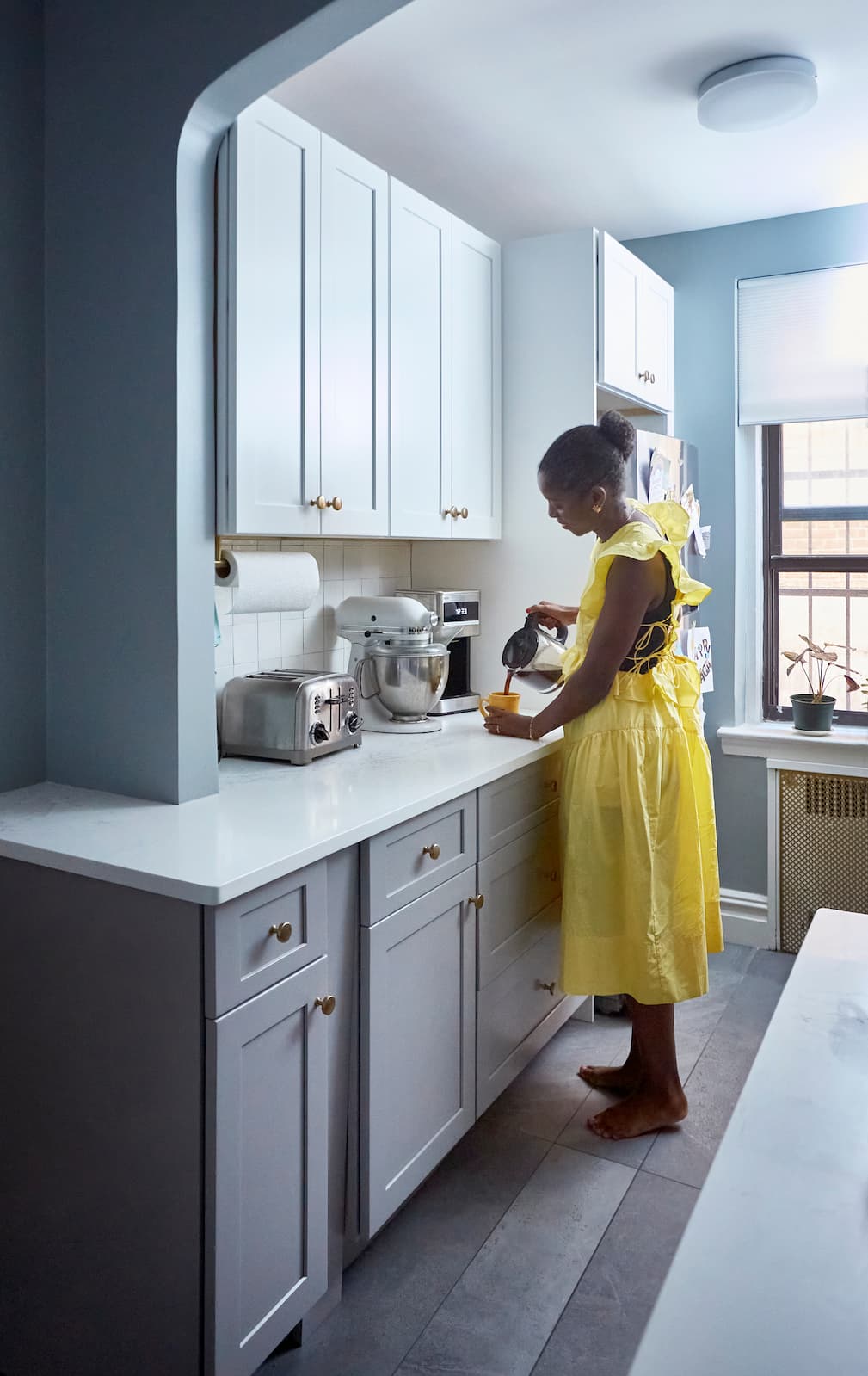
Kitchen
Ideas for Transitional Kitchen Design
12.23.2025
Our New Year savings event is here: Get up to $6,500 off your project today (terms apply).


In This Article
Condo living is anything but one-size-fits-all. Some buildings are sleek high-rises with doormen and strict rules, while others are smaller, more laid-back communities. A kitchen remodel in a Manhattan tower is a very different experience from one in a two-story Bay Area condominium. Still, there are challenges that nearly every condo kitchen remodel has in common—tight spaces, building regulations, and the need to be mindful of neighbors. If you’re considering a kitchen remodel in your condo, understanding these shared realities will help you plan a project that’s both rewarding and realistic.
Remodeling a condo kitchen is a distinct experience compared to working in a single-family home. The process is shaped by building logistics, association approvals, and the need to be mindful of your neighbors. Here’s what you need to know to set your project up for success.
Transporting materials and removing debris in a condo building is rarely straightforward. Unlike a house with a driveway or backyard, your contractor will have to contend with shared hallways, elevators, and loading docks. This means every delivery and removal must be carefully coordinated.
Ultimately, it’s smart to work with a kitchen contractor who has experience in your condo building type and can anticipate these hurdles. Early communication with building management and a detailed logistics plan will help keep your project on track and your neighbors happy.
Securing approval from your condo association is a crucial early step—and one that can make or break your timeline. Boards are tasked with protecting the building and its residents, so they often have strict requirements for renovations.
Kitchen renovations can be disruptive, especially in a building where walls and floors are shared. Maintaining good relationships with your neighbors is essential—not just for peace of mind, but also because complaints can lead to delays or even work stoppages.
Chances are, the chaos of your kitchen remodel won’t be limited to just the kitchen—you’ll hear the noise no matter where you are within your condo. Therefore, in anticipation of the disruption to your regular routine:
Every condo kitchen has its own set of quirks, but thoughtful design can turn even the most challenging space into a place you love to spend time in. Here’s how to address some of the most common issues specific to condo kitchens.
Custom shelving is one of the most effective ways to maximize storage and keep your kitchen clutter-free. Unlike off-the-shelf solutions, custom shelves can be designed around your specific needs and habits. A designer can help you identify what you use most often and create dedicated spaces for those items, making your kitchen more functional and enjoyable.
For example, a homeowner who loves to bake can work with a designer to create deep pull-out shelves for mixing bowls and baking sheets, keeping them within easy reach but out of sight. Another family with young children can add a low, open shelf for snacks and lunchboxes, making it easy for kids to help themselves without cluttering the countertops.
Custom shelving can also be tailored to fit awkward corners or unusual layouts, turning wasted space into valuable storage. By working with a professional, you can ensure that every inch of your kitchen is put to good use, and that your storage solutions reflect your lifestyle—not just generic needs.
Design a Home That’s Uniquely Yours
Block can help you achieve your renovation goals and bring your dream remodel to life with price assurance and expert support.
Get Started
A bland or outdated color scheme can make your kitchen feel uninspired, but a thoughtful palette can completely transform the space. Instead of defaulting to all-white or beige, consider how color can reflect your personality and create a welcoming atmosphere.
For instance, one New York condo owner swapped out tired beige cabinets for a fresh minty green, paired with silvery hardware and a dark floor. The result was a kitchen that felt lively and personal, without overwhelming the small space.

Color doesn’t have to mean bold walls—try colorful lower cabinets, a patterned backsplash, or even just a pop of color on the island. If you’re hesitant, start with accessories or paint a single wall to see how it feels. A designer can help you choose shades that work with your lighting and existing finishes, ensuring the result feels cohesive and inviting. The right color scheme can make your condo kitchen a place you look forward to spending time in, even on busy mornings.
For more inspiration, read Best Colors to Paint Your Kitchen Walls.
Narrow kitchens are a common challenge in condos, but smart remodeling choices can make them feel more open and functional. Choosing slim-profile appliances and fixtures that don’t crowd the space is a good place to start.
A galley layout—common in condos—can be highly efficient if planned well, so keep walkways clear and avoid placing bulky furniture or islands in the middle of the room. Lighting is also key—under-cabinet lights, pendant fixtures, and reflective surfaces can help bounce light around and make the kitchen feel larger. Using vertical space for storage, with tall cabinets or hanging racks for pots and pans, can also help. With the right approach, even the narrowest kitchen can feel comfortable and inviting.
In a condo kitchen, every inch counts, and choosing the right appliances can make a big difference. High-end features aren’t just for large kitchens—there are plenty of models that offer top performance and efficiency without a hefty footprint.
For example, one New York condo owner opted for a small, energy-efficient dishwasher that fit neatly under the counter, freeing up valuable cabinet space. The microwave was installed in a base cabinet rather than above the stove, keeping sightlines open and allowing for more natural light from the window.

When selecting appliances, look for models designed for small spaces, such as counter-depth refrigerators or combination oven-microwaves. Placement matters just as much as size—think about how you move through the kitchen and position appliances where they’ll be most convenient. A designer or contractor can help you evaluate your options and find solutions that fit your needs and your space, so you don’t have to sacrifice function for style.
When remodeling a condo kitchen, it’s important to consider how your choices will affect resale value. An unfortunate truth is that condos can be more challenging to sell than single-family homes, especially when buyers have multiple similar units to compare.
Unusual or highly personalized design choices may appeal to you, but could limit your pool of potential buyers. If your neighbor’s unit has a classic, functional kitchen, a polarizing design in your own space could make it harder to compete when it’s time to sell.
Focus on updates that feel fresh and personal, but still have broad appeal. Quality materials and thoughtful storage solutions are always in demand. If you want to add a unique touch, do so in ways that are easy to change, like paint or hardware, rather than permanent fixtures. By balancing your personal style with market-friendly choices, you’ll create a kitchen you love now—and one that will attract buyers in the future.
Turn your renovation vision into reality
Get matched with trusted contractors and start your renovation today!
Find a Contractor
The cost of a condo kitchen remodel can vary significantly based on location, scope, and the level of finish you choose. In most urban markets, basic remodels typically start around $30,000–$50,000. This usually includes new cabinets, countertops, and appliances, but keeps the existing layout and avoids major plumbing or electrical changes.
Mid-range updates often fall between $50,000–$80,000, and may involve higher-end finishes, semi-custom cabinetry, and some layout adjustments. High-end transformations, which include full custom cabinetry, luxury appliances, premium materials, and significant layout changes, can run $80,000 and up.
Several factors influence the final price: the size of your kitchen, your material choices, and building requirements like permits and insurance. The scope of work also matters—moving plumbing or electrical lines, or making structural changes, will drive up costs. Of course, some markets will be more costly than others; remodeling a condo kitchen in New York will be more than if you do the same project in Philadelphia or Cleveland.
It’s wise to build in a contingency budget of 10–20% for unexpected expenses, especially in older buildings where surprises can arise once work begins.
For more insights, read How Much Does It Cost to Remodel Your Kitchen.
Transparent Pricing You Can Trust

Block Renovation specializes in condo kitchen remodels in major cities across the U.S.—from Queens, NY to San Jose. We know that condo renovations come with unique challenges, from strict building rules to limited space and the need for careful coordination. That’s why we’re highly selective about the contractors we invite into our network, partnering only with professionals who have proven experience and a track record of excellence.
When you work with Block, you get expert support navigating approvals, clear communication throughout your project, and a kitchen that’s designed to fit your space and your life. With our team by your side, you can move forward with confidence, knowing your condo kitchen remodel is in the best possible hands.

Written by Block Renovation

Renovate confidently with Block
Easily compare quotes from top quality contractors, and get peace of mind with warranty & price protections.
Thousands of homeowners have renovated with Block

4.5 Stars (100+)

4.7 Stars (100+)

4.5 Stars (75+)

Kitchen
Ideas for Transitional Kitchen Design
12.23.2025

Kitchen
Modern Rustic Kitchen Designs & Remodels
12.18.2025

Kitchen
Japandi-Style Ideas to Bring to Your Own Small Kitchen Design
12.16.2025

Kitchen
Scandinavian Kitchen Design: Stylish Minimalism
12.16.2025

Kitchen
Non-Tile Kitchen Backsplashes - Alternative Ideas
12.06.2025
Renovate confidently